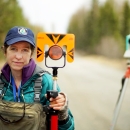About Us
The Appalachian Fish and Wildlife Conservation Office is part of a network of field stations located throughout the nation that works to conserve fish and aquatic resource, protect imperiled species and their habitats, and monitor and control invasive species invasive species
An invasive species is any plant or animal that has spread or been introduced into a new area where they are, or could, cause harm to the environment, economy, or human, animal, or plant health. Their unwelcome presence can destroy ecosystems and cost millions of dollars.
Learn more about invasive species .
What We Do
Our biologists help landowners and other partners assess, plan, and conduct habitat restoration including:
- Restoring wetlands, riparian riparian
Definition of riparian habitat or riparian areas.
Learn more about riparian , in-stream and upland / forested habitats - Removing fish passage fish passage
Fish passage is the ability of fish or other aquatic species to move freely throughout their life to find food, reproduce, and complete their natural migration cycles. Millions of barriers to fish passage across the country are fragmenting habitat and leading to species declines. The U.S. Fish and Wildlife Service's National Fish Passage Program is working to reconnect watersheds to benefit both wildlife and people.
Learn more about fish passage barriers such as dams and culverts - Replacing road-stream crossings and culverts resilient to high water flows and provide better fish passage at all times of the year.
- Controlling invasive species invasive species
An invasive species is any plant or animal that has spread or been introduced into a new area where they are, or could, cause harm to the environment, economy, or human, animal, or plant health. Their unwelcome presence can destroy ecosystems and cost millions of dollars.
Learn more about invasive species - Planting native trees and shrubs
- Fencing livestock out of stream and riparian areas
Projects and Research
The Potomac Headwaters Fish Passage Restoration Project is a watershed scale project to reconnect over 195 miles of habitat for brook trout, American eel, and other aquatic species in the Potomac Headwaters of the Chesapeake Bay across the states of Maryland, Virginia, and West Virginia. The project is composed of up to 17 fish passage barrier removal projects including culvert...
The Partners for Fish and Wildlife program provides technical and financial assistance to private landowners to restore and enhance fish and wildlife habitat on their property. The program’s focus is to restore habitat to benefit federally listed and at-risk species.
Who's Eligible?Technical assistance is available to all landowners. Financial assistance can not be spent on...
West Virginia’s Potomac Headwaters Home Rivers Initiative
Partners: Trout Unlimited, USDA Farm Service Agency, U.S. Fish and Wildlife Service, National Fish and Wildlife Foundation, West Virginia Division of Natural Resources, and West Virginia Conservation Agency
Location: Upper North Fork South Branch Potomac River, West Virginia
The need: High elevations and Project...
Removing three dams on the West Fork River back in 2016 has improved boating access and fish passage along the river. But perhaps more importantly to local residents, the river's water quality and drinking water is improved, and it's safe to go boating and swimming now that the dams have been removed. Indeed, the river is becoming a tourist destination for anglers and boaters - improving...
Across the landscape, undersized, aging and improperly placed road-stream crossings create barriers in our rivers, streams, and tidal wetlands. These structures fragment aquatic habitat and prevent or greatly reduce the ability of aquatic species to move freely to migrate, feed, and reproduce. These poorly designed structures are also more prone to clogging, causing flooding, and washing out...
Location and Contact Information
- Appalachian Fish and Wildlife Conservation OfficeView Details1087 East Main Street White Sulphur Springs, WV 24986-2340
























